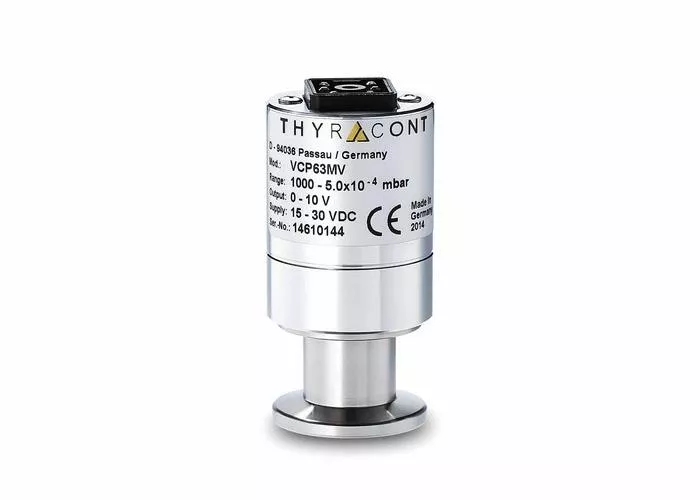In the field of vacuum measurement, accuracy and reliability are of utmost importance. One of the most trusted devices for low-pressure measurement in vacuum systems is the thermocouple gauge. This device is commonly used in laboratories, industrial processes, and scientific applications where monitoring pressure under vacuum is critical. Thermocouple gauges operate based on the thermal conductivity of gases and are particularly useful for measuring pressures in the range of 10-3 to 1 Torr.
What is a Thermocouple Gauge?
A thermocouple gauge is a type of instrumentation device used to measure low vacuum pressures. It operates by detecting temperature changes in a heated filament caused by the thermal conductivity of gas molecules. As the gas pressure changes, the ability of the gas to carry heat away from the filament also changes. This temperature fluctuation is measured by a thermocouple attached to the filament, and the resulting voltage is used to determine the vacuum pressure.
Principle of Operation
The working principle of a thermocouple gauge is based on the relationship between gas pressure and thermal conductivity. At low pressures, fewer gas molecules are available to conduct heat away from the heated filament. As a result, the filament becomes hotter, and the thermocouple voltage increases. Conversely, at higher pressures, more gas molecules are present, allowing for more heat dissipation and a cooler filament. The thermocouple detects this temperature change, which is then translated into an electrical signal proportional to the pressure.
Key Components
- Heated Filament: Usually made of platinum or tungsten, it serves as the heat source.
- Thermocouple: A junction of two dissimilar metals that produces a voltage proportional to the temperature difference.
- Vacuum Tube: The enclosure that houses the filament and thermocouple and allows gas molecules to interact with the heated filament.
- Calibration Circuitry: Converts thermocouple voltage into pressure readings and compensates for non-linearity.
Advantages of Thermocouple Gauges
- Cost-effective and simple to operate.
- Durable with a long service life when operated under clean conditions.
- Effective for a wide range of vacuum pressures.
- Minimal maintenance required.
Limitations
- Non-linear response requiring calibration.
- Limited to low-pressure measurements; not suitable for high or ultra-high vacuum applications.
- Readings affected by gas type; typically calibrated for air or nitrogen.
Applications
Thermocouple gauges are commonly used in various sectors:
- Industrial Vacuum Systems: Monitoring and controlling vacuum pumps and processes.
- Laboratories: Used in vacuum experiments requiring precise pressure measurements.
- Semiconductor Manufacturing: Ensures optimal pressure conditions during production.
- HVAC Systems: Used to diagnose and measure low-pressure environments.
Calibration and Maintenance
Calibration is crucial for accurate measurement. It typically involves comparing the thermocouple gauge against a known standard or using calibration gases. Due to the non-linear relationship between pressure and output voltage, calibration curves are stored in the gauge controller for precise readout.
Regular maintenance includes checking the filament condition, ensuring no contamination, and validating the calibration periodically. Over time, the filament can degrade or become contaminated, affecting accuracy. Proper handling and regular inspections prolong the gauge’s lifespan and maintain measurement integrity.
Comparing Thermocouple Gauges with Other Vacuum Gauges
There are several types of vacuum gauges, including Pirani, ionization, and capacitance manometers. Compared to these:
- Pirani Gauges: Similar principle but often more sensitive and suitable for lower pressures.
- Ionization Gauges: Used for ultra-high vacuum but are more expensive and require delicate handling.
- Capacitance Manometers: Provide direct pressure measurements, ideal for applications requiring high precision.
While thermocouple gauges do not offer the extreme precision or range of ionization gauges, their reliability and simplicity make them a valuable tool in many applications.
How to Interpret Readings
Understanding thermocouple gauge readings involves interpreting the voltage signal generated by the thermocouple. This voltage is non-linear with respect to pressure, so gauge controllers use a pre-defined calibration curve to convert it into a readable pressure value. The user interface of the gauge typically displays pressure in Torr, mbar, or Pascal units.
Because gas composition affects thermal conductivity, the gauge should be used with the gas it was calibrated for, or appropriate correction factors must be applied. For precise readings in mixed-gas environments, other types of vacuum gauges may be more suitable.
Conclusion
Thermocouple gauges remain an indispensable tool in the realm of vacuum technology. Their cost-effectiveness, reliability, and simplicity make them ideal for a wide array of applications, from industrial processes to research laboratories. Understanding how these gauges work, their strengths and limitations, and how to maintain them is essential for any professional dealing with low-pressure environments. As technology continues to advance, thermocouple gauges will likely become even more capable and integrated into smart systems, reinforcing their role in precision vacuum measurement.
FAQs
Q1: What is the pressure range of a thermocouple gauge?
A: Typically, thermocouple gauges measure pressures from about 10-3 Torr to 1 Torr.
Q2: Can a thermocouple gauge be used with any gas?
A: No. Thermocouple gauges are calibrated for specific gases like air or nitrogen. Use with other gases requires correction factors.
Q3: How often should a thermocouple gauge be calibrated?
A: Regular calibration is recommended every 6–12 months or whenever there is a noticeable change in readings.
Q4: What are common failure modes of thermocouple gauges?
A: Filament burnout, contamination, and calibration drift are common failure issues.
Q5: Can thermocouple gauges be used in high vacuum systems?
A: No, they are best suited for low to medium vacuum applications. For high vacuum, use ionization or capacitance manometers.

